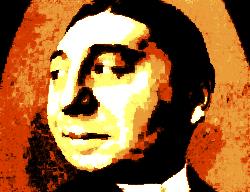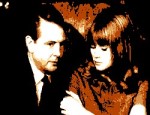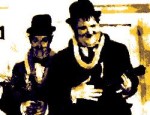Biography: life and films

Léonce Joseph Perret was born on 14th March 1880, at Niort in the Deux-Sèvres department of western France. His parents owned a carpentry business and he had two older siblings, a brother Ernest and sister Lucie. From an early age, Léonce had artistic leanings that included an avid interest in literature, poetry and music. After he was exempted from military service on health grounds, he went to Paris to attend a music school, Schola Cantorum, with the aim of becoming a musician. As he did so, he acquired an interest in the theatre and started taking drama lessons. He began appearing in stage productions not long afterwards and landed a contract with the Théâtre de l'Athénée. In 1905, he signed another contract with the Odéon, where he was directed by Abel Tarride and André Antoine. Four years later, he was engaged by the Saint Petersburg Theatre.
It was whilst he was performing Cyrano de Bergerac on stage in Berlin that Léonce Perret came to the attention of Georges Grasset, the director of Gaumont's German subsidiary. It was Grasset who persuaded the 28 year old actor to become involved with the new medium of cinema. On his return to Paris, Perret was soon taken on by Gaumont and, working closely with the company's artistic director Louis Feuillade, was soon busy churning out short films that encompassed the entire dramatic range, from comedies and melodramas to adventure films and thrillers. In total, Perret directed around 350 films during his time at Gaumont, and acted in many of his films. One of his first films was Molière (1909), an early biopic for which Abel Gance was hired to play the young playwright.
It was around this time that Léonce Perret met the dancer and singer Valentine Petit. They married a short while later and Petit became not only the director's muse, taking the lead in several of his films, but also his personal assistant. Petit's strong personality and controlling influence would often cause ructions on the set. Perret was better served by his other discovery, Suzanne Grandais, a performer at the Moulin Rouge who had a prominent career as a film actress until her tragic death at the age of 27 in 1920. Grandais lent her talents to some of the director's more accomplished films of this time, including the comedy Le Chrysanthème rouge (1912) and well-paced thriller Le Mystère des roches de Kador (1912). The latter's importance isn't confined to its obvious artistic qualities (the location photography in Brittany is particularly striking), it also inspired Feuillade to make his thriller serials - Fantômas, Les Vampires, Judex - hefty crowdpleasers that soon become Gaumont's most lucrative line.
In 1912, Perret embarked on his series of Léonce shorts (Léonce fait des gaffes, Léonce à la campagne, Léonce et les écrevisses, ...) - around forty in total, comprising a mix comedies and dramas. Such was the immense popularity of these films that the director soon realised the commercial value of star billing. At the time, it was not the practice for directors' and actors' names to appear on the film, and Léon Gaumont took some persuading to be convinced of the merit of doing so. Perret got his way and by placing the actors' names on the screen at the start of his films he initiated the star system that would have massive implications for cinema.
Léonce Perret learned a great deal from his mentor Louis Feuillade and shared his love of the weird and macabre (apparent in films such as Sur les rails (1912) and Les Dents de fer (1913)). But so enthusiastic and gifted an experimenter was he that he soon surpassed his master, by introducing techniques that would make Feuillade's films appear grimly static and theatrical. Perret had the honour of directing Gaumont's first feature-length film, L'Enfant de Paris (1913), and with its use of close-ups, deep focus and camera movement it was a dramatic step forward. The film brought its director international renown and put him on a par with America's great film innovator, D.W. Griffith. Perret followed this with another ambitious feature, Le Roman d'un mousse (1914), a compelling adventure thriller.
By now France was leading the world in cinema and Léonce Perret was French cinema's greatest creative talent (surpassing even Pathé's star director Albert Capellani in both innovation and productivity). The outbreak of the First World War in the summer of 1914 would end all that. Over the next four years, commercial filmmaking in France was throttled back through rationing of scarce materials and America soon overtook its one European rival to become the dominant force in cinema exploitation - a position it has occupied ever since.
At the start of the conflict, Perret was called up but, because of his health, he only served for a short time as a medical orderly in Niort. In 1915, Gaumont called him back to make a series of propaganda films, including Françaises, veillez! Perret took over as the company's artistic director but soon became frustrated by the lack of resources. He desperately wanted to make more ambitious films, as Gaumont's rival Pathé had been doing for some years, and this led him to move to the United States in 1917, to work for World Film Corporation in Richard, Virginia. In addition to popular melodramas such as The Silent Master (1917) and The Mad Lover (1917), Perret also directed a patriotic piece Lest We Forget (a.k.a. N'oublions jamais) which proved to be a massive hit in France.
Now financially secure, Perret founded his own film production company, Perret Pictures Inc., although this made only three films, the most interesting being Lifting Shadows (1920), a forthright attack on bolshevism. With the American film industry badly hit by a sudden economic downturn, Perret returned to France in 1921 and directed L'Écuyère (1922) for Pathé. Perret's next feature, Koenigsmark (1924), is considered his masterpiece and represents one of the pinnacles of the silent era. This was followed by Madame Sans-Gêne (1925), showcasing the talents of American star Gloria Swanson - significantly this was the first Franco-American film production, although it is now lost. For Pathé-Natan, Perret directed La Femme nue (1926), and then took up the post of artistic director at the recently created company Franco-Film, based in Nice. The first film he directed for the company, Morgane la sirène (1927), was a major success, and this was followed by La Danseuse orchidée (1928) and La Possession (1929).
The arrival of sound was a challenge that Léonce Perret embraced with his customary enthusiasm. Over the next fifteen years he would direct only seven sound films and it is fair to say he never fully came to grips with the new medium. His first sound Quand nous étions deux (1929), was only a modest success, and after the failure of Franco-Film Perret's creativity was stymied on his further productions with Adolphe Osso (Arthur (1931)) and Pathé-Natan (Après l'amour (1931), Enlevez-moi (1932)). Of his sound films, Il était une fois (1933) is the one that attracted most critical acclaim. The last feature that Perret completed, Un soir à la Comédie-Française (1935), in an interesting experimental piece that combines theatre and documentary with extracts from plays by Molière and Sacha Guitry performed by actors of the Comédie-Française. Perret was preparing a sound version of Koenigsmark when he fell ill and had to be hospitalised. It was whilst being treated at the Saint Jean de Dieu clinic in Paris that he died, on 12th August 1935. He is now buried in his birth town of Niort.
© James Travers 2017
The above content is owned by frenchfilms.org and must not be copied.
Filmography
Click here to view complete list of films...The very best of the French New Wave

The very best American film comedies

The very best of Italian cinema
